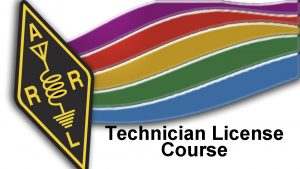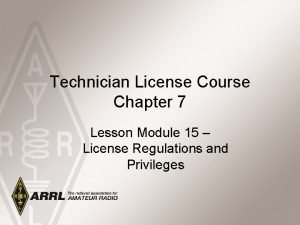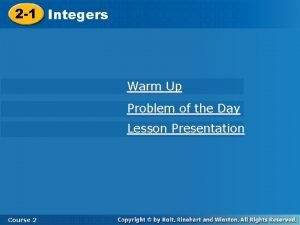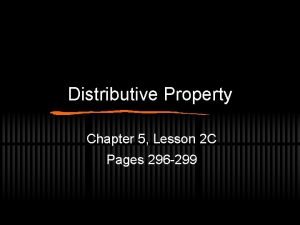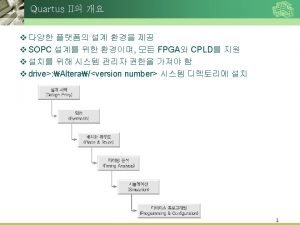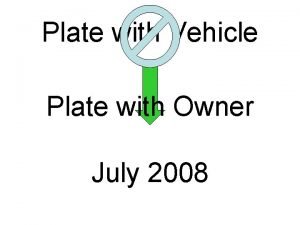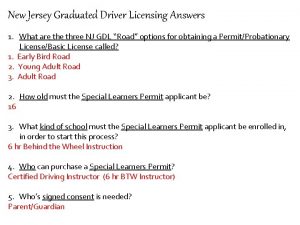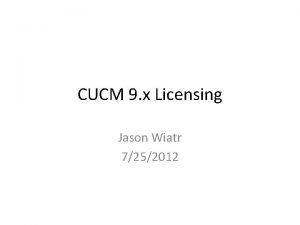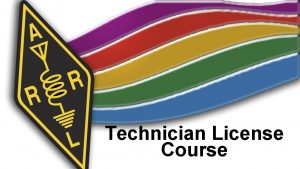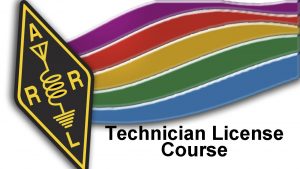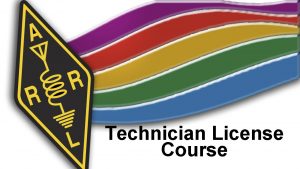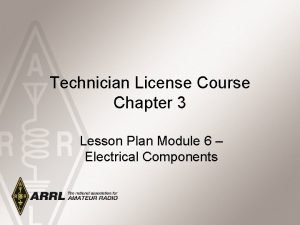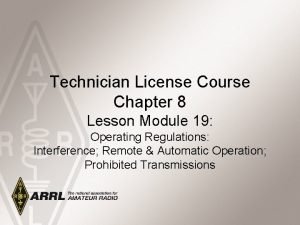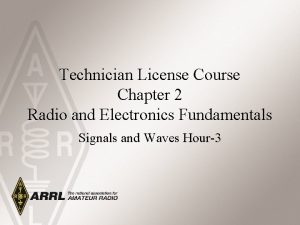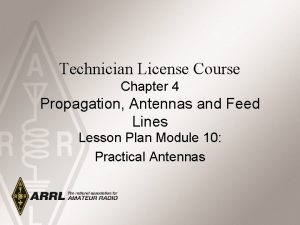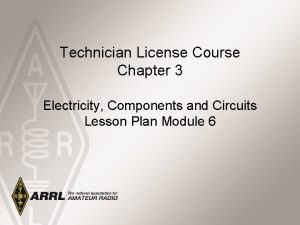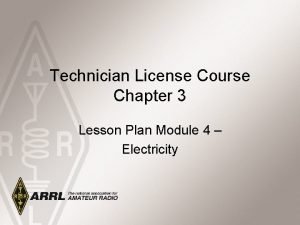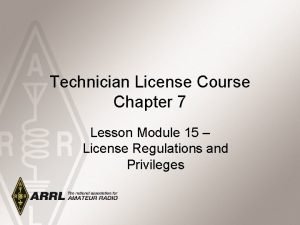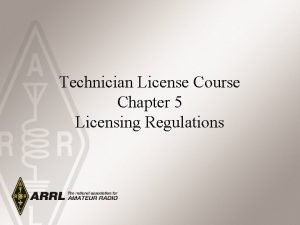Technician License Course Technician License Course Chapter 3


















































































- Slides: 82

Technician License Course

Technician License Course Chapter 3 Lesson Plan Module - 7 Types of Radio Circuits

The Basic Transceiver

The Basic Transceiver • Combination of “transmitter” and “receiver”

The Basic Transceiver • Combination of “transmitter” and “receiver” • Abbreviated “XCVR” (X = trans)

The Basic Transceiver • Combination of “transmitter” and “receiver” • Abbreviated “XCVR” (X = trans) • Antenna switched between transmitter and receiver by the TR switch

Transmit/Receive (TR) Switch

Transmit/Receive (TR) Switch • TR switch allows a single antenna to be switched to the transmitter when sending and to the receiver when receiving.

Transmit/Receive (TR) Switch • TR switch allows a single antenna to be switched to the transmitter when sending and to the receiver when receiving. –In a transceiver, the TR switch is inside the unit and operates automatically.

Transmit/Receive (TR) Switch • TR switch allows a single antenna to be switched to the transmitter when sending and to the receiver when receiving. –In a transceiver, the TR switch is inside the unit and operates automatically. –Transceivers cannot transmit and receive at the same time like a repeater.

The Basic Repeater

The Basic Repeater • Relays signals from low-power stations over a wide area

The Basic Repeater • Relays signals from low-power stations over a wide area • Simultaneously re-transmits received signal on the same band

The Basic Repeater • Relays signals from low-power stations over a wide area • Simultaneously re-transmits received signal on the same band • TR switch replaced with duplexer which allows antenna to be shared without switching

What Happens During Radio Communication? (Review)

What Happens During Radio Communication? (Review) • Transmitting (sending a signal):

What Happens During Radio Communication? (Review) • Transmitting (sending a signal): –Information (voice, data, video, commands, etc. ) is converted to electronic form.

What Happens During Radio Communication? (Review) • Transmitting (sending a signal): –Information (voice, data, video, commands, etc. ) is converted to electronic form. –The information in electronic form is added to a radio wave.

What Happens During Radio Communication? (Review) • Transmitting (sending a signal): –Information (voice, data, video, commands, etc. ) is converted to electronic form. –The information in electronic form is added to a radio wave. –The radio wave carrying the information is sent from the station antenna into space.

What Happens During Radio Communication? (Review) • Receiving:

What Happens During Radio Communication? (Review) • Receiving: –The radio wave carrying the information is intercepted by the receiving station’s antenna.

What Happens During Radio Communication? (Review) • Receiving: –The radio wave carrying the information is intercepted by the receiving station’s antenna. –The receiver extracts the information from the received wave.

What Happens During Radio Communication? (Review) • Receiving: –The radio wave carrying the information is intercepted by the receiving station’s antenna. –The receiver extracts the information from the received wave. –The information is then presented to the user in a format that can be understood (sound, picture, words on a computer screen, response to a command, etc. ).

What Happens During Radio Communication? (Review) • Adding and extracting the information can be simple or complex.

What Happens During Radio Communication? (Review) • Adding and extracting the information can be simple or complex. • This makes ham radio fun…learning all about how radios work.

What Happens During Radio Communication? (Review) • Adding and extracting the information can be simple or complex. • This makes ham radio fun…learning all about how radios work. • Don’t be intimidated. You will be required to only know the basics, but you can learn as much about the “art and science” of radio as you want.

Filters

Filters • Circuits that act on signals differently according their frequency.

Filters • Circuits that act on signals differently according their frequency. • Filters can reject, enhance, or modify signals.

Types of Filters

Adding Information - Modulation

Adding Information - Modulation • When we add some information to the radio wave (the carrier), we modulate the wave.

Adding Information - Modulation • When we add some information to the radio wave (the carrier), we modulate the wave. • Morse code (CW), speech, data

Adding Information - Modulation • When we add some information to the radio wave (the carrier), we modulate the wave. • Morse code (CW), speech, data • Different modulation techniques vary different properties of the wave to add the information:

Adding Information - Modulation • When we add some information to the radio wave (the carrier), we modulate the wave. • Morse code (CW), speech, data • Different modulation techniques vary different properties of the wave to add the information: • Amplitude, frequency, or phase

Adding Information - Modulation • Modulator and demodulator circuits

Adding Information - Modulation • Modulator and demodulator circuits • Modulators add information to an RF signal, demodulators recover the information

Changing Frequency - Mixers

Changing Frequency - Mixers • Signal frequencies can be changed by combining with another signal, called mixing

Changing Frequency - Mixers • Signal frequencies can be changed by combining with another signal, called mixing • Also referred to as heterodyning

Changing Frequency - Mixers • Signal frequencies can be changed by combining with another signal, called mixing • Also referred to as heterodyning • Two signals are combined in a mixer

Changing Frequency - Mixers • Signal frequencies can be changed by combining with another signal, called mixing • Also referred to as heterodyning • Two signals are combined in a mixer • Generates mixing product signals

Changing Frequency - Mixers • Signal frequencies can be changed by combining with another signal, called mixing • Also referred to as heterodyning • Two signals are combined in a mixer • Generates mixing product signals • Sum and difference of the input signals

Changing Frequency - Mixers • Signal frequencies can be changed by combining with another signal, called mixing • Also referred to as heterodyning • Two signals are combined in a mixer • Generates mixing product signals • Sum and difference of the input signals • Shifts frequency by adding or subtracting

Changing Frequency - Mixers • Signal frequencies can be changed by combining with another signal, called mixing • Also referred to as heterodyning • Two signals are combined in a mixer • Generates mixing product signals • Sum and difference of the input signals • Shifts frequency by adding or subtracting • Different than a multiplier which multiplies a signal’s frequency by some integer, usually 2 or 3

Sensitivity and Selectivity

Sensitivity and Selectivity • Two essential tasks for a receiver:

Sensitivity and Selectivity • Two essential tasks for a receiver: • Hear a signal and hear only one signal

Sensitivity and Selectivity • Two essential tasks for a receiver: • Hear a signal and hear only one signal • Sensitivity is a measure of how well the receiver can detect weak signals

Sensitivity and Selectivity • Two essential tasks for a receiver: • Hear a signal and hear only one signal • Sensitivity is a measure of how well the receiver can detect weak signals • Selectivity is a measure of the receiver’s ability to discriminate between signals

Sensitivity and Selectivity • Two essential tasks for a receiver: • Hear a signal and hear only one signal • Sensitivity is a measure of how well the receiver can detect weak signals • Selectivity is a measure of the receiver’s ability to discriminate between signals • Preamplifiers make a receiver more sensitive

Sensitivity and Selectivity • Two essential tasks for a receiver: • Hear a signal and hear only one signal • Sensitivity is a measure of how well the receiver can detect weak signals • Selectivity is a measure of the receiver’s ability to discriminate between signals • Preamplifiers make a receiver more sensitive • Preamplifiers added between antenna and receiver

Transverter

Transverter • Short for “transceiving converter” (XVTR)

Transverter • Short for “transceiving converter” (XVTR) • Converts a transceiver to operate on another band

Transverter • Short for “transceiving converter” (XVTR) • Converts a transceiver to operate on another band • Usually to a higher frequency

Transverter • Short for “transceiving converter” (XVTR) • Converts a transceiver to operate on another band • Usually to a higher frequency • External mixers shift frequency

Transverter • Short for “transceiving converter” (XVTR) • Converts a transceiver to operate on another band • Usually to a higher frequency • External mixers shift frequency • Typical examples

Transverter • Short for “transceiving converter” (XVTR) • Converts a transceiver to operate on another band • Usually to a higher frequency • External mixers shift frequency • Typical examples • HF SSB/CW at 28 MHz converted to/from 222 MHz

Transverter • Short for “transceiving converter” (XVTR) • Converts a transceiver to operate on another band • Usually to a higher frequency • External mixers shift frequency • Typical examples • HF SSB/CW at 28 MHz converted to/from 222 MHz • VHF SSB/CW at 144 MHz converted to/from 10 GHz

Practice Questions

What type of amateur station simultaneously retransmits the signal of another amateur station on a different channel or channels?

What type of amateur station simultaneously retransmits the signal of another amateur station on a different channel or channels? Repeater station

Which term describes the ability of a receiver to detect the presence of a signal?

Which term describes the ability of a receiver to detect the presence of a signal? Sensitivity

What is a transceiver?

What is a transceiver? A unit combining the functions of a transmitter and a receiver

Which of the following is used to convert a radio signal from one frequency to another?

Which of the following is used to convert a radio signal from one frequency to another? Mixer

Which term describes the ability of a receiver to discriminate between multiple signals?

Which term describes the ability of a receiver to discriminate between multiple signals? Selectivity

What is the name of a circuit that generates a signal of a desired frequency?

What is the name of a circuit that generates a signal of a desired frequency? Oscillator

What device takes the output of a lowpowered 28 MHz SSB exciter and produces a 222 MHz output signal?

What device takes the output of a lowpowered 28 MHz SSB exciter and produces a 222 MHz output signal? Transverter

Which of the following describes combining speech with an RF carrier signal?

Which of the following describes combining speech with an RF carrier signal? Modulation

What device increases the low-power output from a handheld transceiver?

What device increases the low-power output from a handheld transceiver? An RF power amplifier

Where is an RF preamplifier installed?

Where is an RF preamplifier installed? Between the antenna and receiver

End of Module 7
 Manufacturing technician license
Manufacturing technician license Manufacturing technician license
Manufacturing technician license English bond t junction
English bond t junction Course title and course number
Course title and course number Course interne course externe
Course interne course externe Getting a driver license illegally may result in
Getting a driver license illegally may result in Chapter 1 the new jersey driver license system answers
Chapter 1 the new jersey driver license system answers Chapter 1 the new jersey driver license system answers
Chapter 1 the new jersey driver license system answers What is coring in pharmacy
What is coring in pharmacy How long must a technician evacuating refrigerant
How long must a technician evacuating refrigerant Vet tech pros and cons
Vet tech pros and cons Maximo pm forecasting
Maximo pm forecasting Asq cct
Asq cct 5 healthcare career pathways
5 healthcare career pathways Radar and sonar technician career cluster
Radar and sonar technician career cluster Technician a says that the bulb trade number
Technician a says that the bulb trade number Toyota technician certification
Toyota technician certification Micromain mobile
Micromain mobile Mtm pharmacy technician
Mtm pharmacy technician Scheduler plus
Scheduler plus Rbt session note example
Rbt session note example Surface repair technician
Surface repair technician She technician apprenticeship
She technician apprenticeship Translator
Translator Live technician
Live technician Ultrasound guidelines council
Ultrasound guidelines council Coding and logic exam questions
Coding and logic exam questions A csi lab technician _____.
A csi lab technician _____. Horticultural technician apprentice
Horticultural technician apprentice Acoustic technician
Acoustic technician Special effects technician salary
Special effects technician salary How to become a weatherization technician
How to become a weatherization technician Level 9 technician
Level 9 technician Technician class privileges
Technician class privileges Tracemp
Tracemp Pci wind turbine technician
Pci wind turbine technician Pharmacy technician george brown
Pharmacy technician george brown Cot skills simulator
Cot skills simulator Commonly damaged areas of a vehicle during hoisting
Commonly damaged areas of a vehicle during hoisting Ecc x ray technician
Ecc x ray technician Dtabc
Dtabc Course 2 chapter 1 ratios and proportional reasoning
Course 2 chapter 1 ratios and proportional reasoning Steve wyborney splat
Steve wyborney splat Chapter 13 personal financial management course
Chapter 13 personal financial management course Integers warm up
Integers warm up 9(3+c+4) distributive property
9(3+c+4) distributive property Esti mysteries kindergarten
Esti mysteries kindergarten Work based learning license mn
Work based learning license mn Wisconsin ems e licensing
Wisconsin ems e licensing Cssm cisco
Cssm cisco Chapter 12 of percy jackson and the lightning thief
Chapter 12 of percy jackson and the lightning thief Coam master acct
Coam master acct Tbote website
Tbote website Spla usage report
Spla usage report Quartus ii web edition download
Quartus ii web edition download Michigan raffle license application
Michigan raffle license application Sd temporary license plate
Sd temporary license plate Oregon lpn scope of practice
Oregon lpn scope of practice Omma complaint form
Omma complaint form Nj 6 points of identification
Nj 6 points of identification Graduated drivers license nj
Graduated drivers license nj Sap renewal negotiation
Sap renewal negotiation Nc license and theft bureau
Nc license and theft bureau Miplus account
Miplus account Ncbop
Ncbop Doctors license number
Doctors license number Kofax vrs administration console
Kofax vrs administration console Kbn application status
Kbn application status Taxi license finland
Taxi license finland Sas license cost
Sas license cost Initial licensing phase
Initial licensing phase Hid mobile portal
Hid mobile portal Ontario pesticide regulations
Ontario pesticide regulations Emd license
Emd license Rok vs oem
Rok vs oem John doe drivers license
John doe drivers license Dcas license how to apply
Dcas license how to apply Dmc trade license fees
Dmc trade license fees Cucm enhanced license
Cucm enhanced license Software licensing best practices
Software licensing best practices Bc gaming license
Bc gaming license Specialty cottage indoor license
Specialty cottage indoor license Capa-cs collaborative agreement
Capa-cs collaborative agreement
































